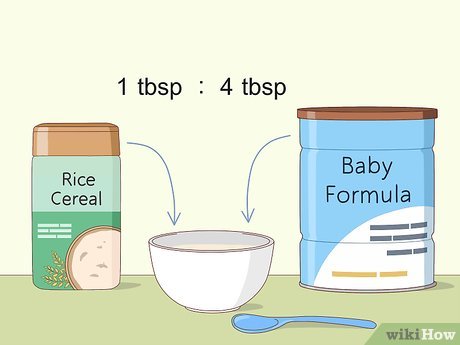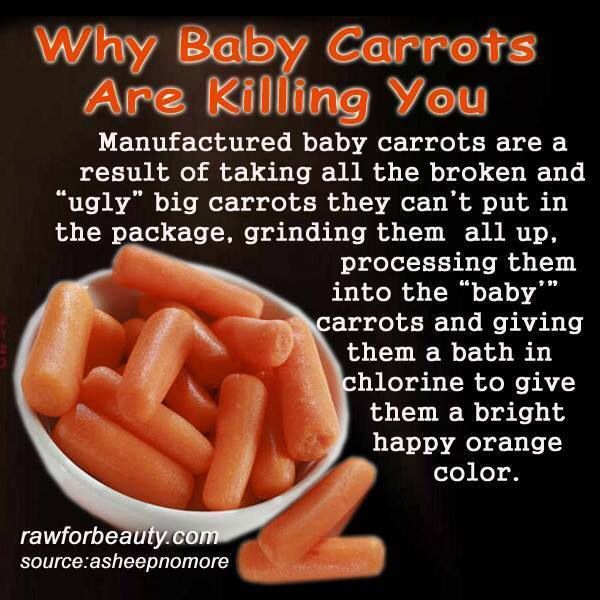When to start giving baby finger foods
Giving Baby Finger Foods at 7-8 Months
Written by Rebecca Felsenthal Stewart
Month 7, Week 3
featureOnce your baby is a pro at eating soft mashed foods, they may be ready to move on to finger foods around 8 months. They have the dexterity to pick the food up and release it or mash it, and will become more efficient and independent as they master the pincer grip around 9 months. At that point they'll be able to use their thumb and forefinger to pick up the small chunks of food.
Your baby may grab at everything on your plate, but follow these guidelines for healthy and safe feedings.
- Start with menu items like pieces of soft cheese; small pieces of pasta or bread; finely chopped soft vegetables; and fruits like bananas, avocado, and ripe peaches or nectarines. These foods should require minimal chewing, as your baby may not yet have teeth. Do NOT let them have hot dogs, raw vegetables, nuts, meats, hard candy, or sticky textures such as nut butters that have increased choking risks at this stage.
- Introduce new foods one at a time in case there are any concers about allergies.
- Chop all foods into soft, bite-sized pieces, 1/2 inch or smaller.
- Watch out for choking hazards: Avoid round, firm foods like carrots, grapes, and hot dogs and skip anything like raw veggies and peanuts. Raisins and popcorn are dangerous for babies.
- Keep up your formula or breastfeeding schedule, but as your baby eats more solids, they’ll naturally start to take less milk. Your baby needs to start eating more solids and drinking less milk for the nutritional value at this stage.
Your Baby's Development This Week
Your baby is getting stronger and may even be moving around, whether they are sliding around on their belly in reverse, scooting on their behind, or actually crawling forward. If you haven’t childproofed your house already, don’t wait any longer!
You may notice these growing signs of motor development:
- Your baby is probably now able to sit on their own for several minutes, without using their hands for support and they may be able to get up into a sitting position all by themselves.

- While you offer them support, they should be able to bounce up and down, and possibly even pull up to a stand.
- Their little hands are increasingly agile -- they are getting better at passing a toy back and forth from one to the other.
You might wonder about:
- Their vision. Your baby should be able to see nearly as far as an adult by now and can track moving objects with their eyes.
- Stranger anxiety. You’re not imagining it: They may fear new people and situations. So give them time to warm up and reassure them if they are upset.
- What they can understand. Your baby might comprehend more than you realize, so it’s important to keep talking to them about everything you’re doing and try to be consistent about the words you use for familiar objects.
Month 7 Week 3 Tips
tips- If food allergies run in the family, talk to your pediatrician about introducing highly allergenic foods like peanuts and eggs.

- Fried foods are not good choices for babies. If you offer them at all, do so rarely.
- Avoid feeding your baby juice unless it is fresh-squeezed.
- By now, your baby’s diet should include grains, fruits, vegetables, and meats, and they should be eating two to three meals a day.
- In addition to rice, barley, or oat cereal, you can introduce grain products your baby can grab, such as toast, crackers, and dry cereal. Avoid any colorful, sugary cereals.
- Sit baby in their high-chair for feeding time. If they eat finger foods while crawling around, they are more likely to choke.
- You’re not done with breast feeding or bottle feeding. Your baby is starting the transition, but breast milk and formula are still key.
- Pureeing or mashing vegetables may make them easier for your baby to eat when they are first transitioning from a liquid diet to solids.
When to Start Finger Foods for Babies
Listen to this article:
Your browser does not support the audio tag.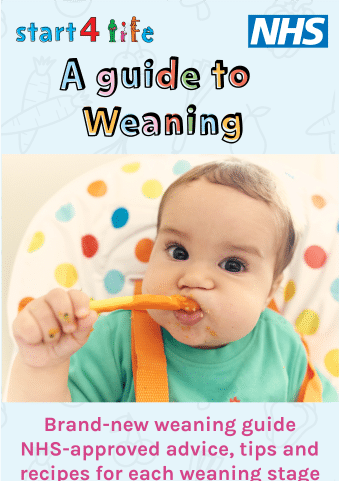
Feeding your baby can be an exciting time but may also come with some fears and frustrations.
Eating is a skill your baby is continuing to learn as they grow and develop. Knowing when to introduce finger foods to infants can be tricky given that a baby’s eating skills develop at different times.
Whether you introduce solid food to your baby through purees or have chosen to adopt a baby-led weaning approach, every transition will help support your baby’s continued growth and development as they master the art of self-feeding.
How Do I Know When My Baby is Ready for Finger Foods?
A natural question many parents have is when to start finger foods for their baby. As your baby’s motor skills are developing, you may notice that they grasp toys with their hands or even pick up small objects with two fingers. These motor skills are an indication that your baby may be ready for finger foods.
Palmar Grasp
Your baby’s palmar grasp will generally begin to develop around 5-6 months. The palmar grasp occurs when all four fingers curl around an object, while the thumb is tucked inside the palm.
The palmar grasp occurs when all four fingers curl around an object, while the thumb is tucked inside the palm.
Some families opt out of pureed foods and follow what is called a baby-led weaning approach.
In this case, your baby will have mastered the palmar grasp and will begin eating stick-shaped foods. The shape allows for most of the food to remain in the palm of their hand while some sticks out of the top of their hand, which is what they will ultimately chew on.
Pincer Grasp
Around 7 to 8 months your child may have developed a pincer grasp. This milestone involves using the tip of the index finger and the thumb to pick up small pieces of food.
While experimenting with self-feeding, you can offer your baby stick-shaped pieces of food in addition to smaller pieces of food.
As your baby’s development continues, you may notice that they switch between using a palmar and pincer grasp, even during the same meal. Eventually, your baby’s fine motor skills will become more honed allowing them to use the pincer grasp with ease.
There is no hard and fast rule about when a child is ready for baby finger foods. All babies develop at varying times; therefore, the exact age of introducing finger foods will vary as well.
Additional signs that point to baby finger food readiness include:
- Sitting with minimal assistance
- Bringing hands to their mouth intentionally
- Having strong head and trunk control
- Being curious about food and may reach towards your plate
You may be wondering if your baby needs teeth to begin eating finger foods. Surprisingly, all humans actually chew food with their back molars, which your baby won’t get until they’re around 20 months old. Thankfully, your baby has strong and sturdy gums which will enable them to mash and chew foods without any problems before their back molars arrive.
Now that you know when to start finger foods for your baby, you may be curious as to how to do so. There is no one right way to introduce baby finger foods. If they are between 6 and 9 months of age and showing signs that they are ready, you may consider the following methods of first food introduction:
If they are between 6 and 9 months of age and showing signs that they are ready, you may consider the following methods of first food introduction:
Traditional Weaning
In a traditional weaning approach, you will begin feeding your baby smooth pureed foods and then slowly progress to slightly thicker purees. This is often referred to as spoon-feeding. Eventually, your baby will transition to thicker texture purees that have pieces or chunks mixed in that your baby has to chew.
Once your baby has progressed through the various stages of pureed foods, they may be ready to explore baby finger foods as their next step in self-feeding.
Baby-Led Weaning
In a baby-led feeding approach, you will skip the purees phase altogether and move right into solid foods. Baby-led weaning typically takes place around 6 months of age.
Remember, your baby may have mastered the palmar grasp but not the pincer grasp at this age. Therefore, it’s important that the food is cut into stick shapes roughly the width of one or two adult fingers rather than in smaller pieces. Cutting food into stick shapes will make grasping easier and less frustrating for your baby.
Therefore, it’s important that the food is cut into stick shapes roughly the width of one or two adult fingers rather than in smaller pieces. Cutting food into stick shapes will make grasping easier and less frustrating for your baby.
Additionally, the texture of your baby’s food at this stage is of utmost importance. On one hand, foods should be soft but not too soft that they turn to mush when picked up.
On the other hand, your baby’s food shouldn’t be too hard as it could create a potential choking hazard.
Combining Weaning Approaches
Remember, there is no one-size-fits-all approach to feeding your baby.
Another way to introduce finger foods to your baby is to use a combination of a traditional method and a baby-led approach. In this feeding method, you can present both purees and finger foods to your baby at the same time.
For example, you may begin a meal with pureed food and then offer some finger foods to complement that meal.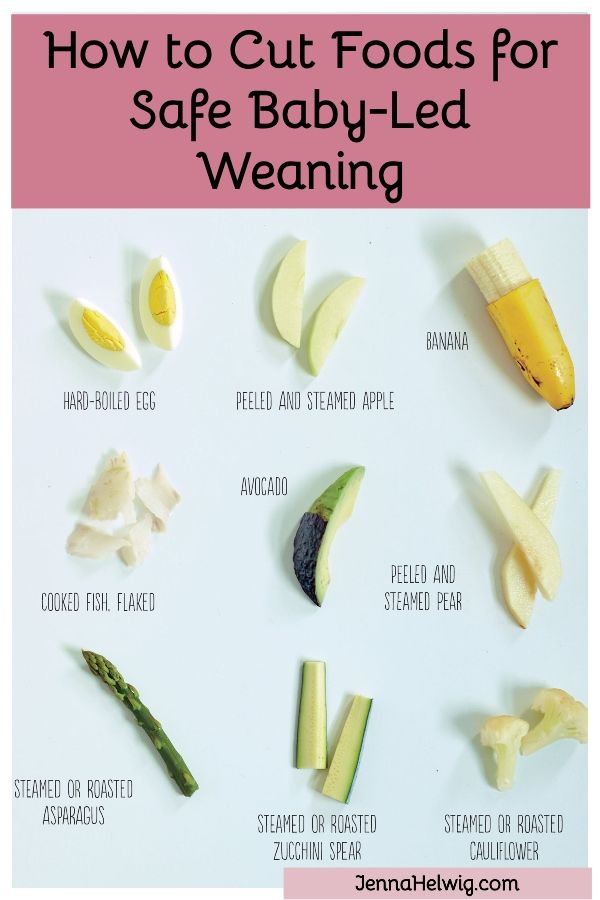 Additionally, you may encourage your baby to dip a finger food into their puree to experiment with different textures.
Additionally, you may encourage your baby to dip a finger food into their puree to experiment with different textures.
Regardless of which feeding approach you choose, you’ll want to be mindful of safety and follow your baby’s feeding cues.
Rather than have your baby sit on the floor or toddle around the house during feedings, ensure they are in a highchair or booster seat that supports their trunk and hips. This will minimize the risk of choking.
Begin with 1 or 2 foods rather than many. This will help your baby feel less overwhelmed and also allow you to assess their tolerance of specific foods.
Allow for 2 to 3 days of giving your baby one food before introducing a new food into their diet to make sure they are not allergic to that food. Foods most often associated with allergies are eggs, soy, peanuts, tree nuts and seeds, wheat, fish, shellfish, and cow’s milk.
If your child is using a pincer grasp, cut foods into pea-sized pieces to allow your baby to work on this fine motor skill.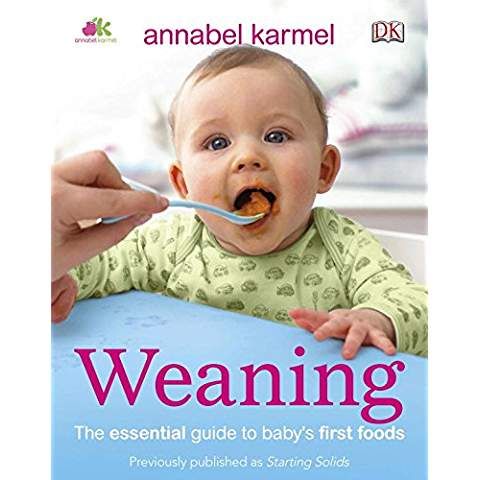 Their food should be soft enough that it can easily squish between the fingers.
Their food should be soft enough that it can easily squish between the fingers.
As your child explores new foods, let them determine what and how much they want to eat. Create a low-stress environment by avoiding high-pressure language like “take one more bite”, and “you need to finish this”. This will help set the stage for healthy eating habits as your baby continues to develop and grow.
What are Good Finger Foods for Babies?
The best finger foods for babies will be soft, small, easily gummed, and nutritious. There are many great baby finger food ideas that can encourage self-feeding skills and provide important nutrition for your growing baby.
The following are some examples:
Vegetable Finger Foods:
- Roasted sweet potato mashed and broken up into small pieces
- Warmed frozen peas
- Zucchini or yellow squash, softened, roasted cut into small pieces
- Butternut Squash, softened, roasted cut into small pieces
- Avocado, ripened and diced
- Well-cooked broccoli or cauliflower cut into small pieces
Fruit Finger Foods:
- Raspberries, broken up into small pieces
- Blueberries, cut in half
- Banana, broken into small pieces
- Ripe peach, cut into small pieces
- Ripe mango, cut into small pieces
- Watermelon, cut into small pieces
Protein Finger Foods:
- Eggs, scrambled and broken up into small pieces
- Tofu, steamed and diced
- Ground beef, chicken, or turkey, broken up into small pieces
- Shredded cheese
- Salmon, cooked and flaked
- Lightly mashed beans
- Edamame, cut in half as needed
Carbohydrate Finger Foods:
- Puffs and O-shaped dry cereal
- Pasta, well cooked in small pieces
- Bread, lightly toasted and cut into very small pieces or thin strips
- Muffins, diced
- Pancakes, diced or cut into thin strips
- Rice, in small clumps
- Quinoa, in small clumps
Sample Meal Plan for 6-to-9-Month Old Baby
While breast milk or formula will remain your baby’s primary source of nutrition during their first year, introducing solids will allow your baby to explore different textures and flavors all while enhancing their fine motor skills.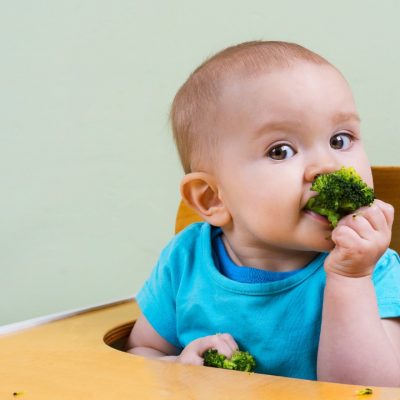
Below is a sample meal plan for your baby:
Breakfast: Mashed avocado
Lunch: Quinoa cereal or quinoa in clumps
Dinner: Soft cooked pasta with steamed broccoli cut into small pieces
If your baby is hungry between meals, you may want to offer snacks. For example, if you’re looking for snacks for your 7-month old, consider pieces of banana, O-shaped cereal or puffs, chunks of tofu, or fresh blueberries cut in half.
Can I Freeze Finger Foods for the Baby?
Just like you may like to meal prep for yourself, having ready-made finger foods for your baby in your freezer can be a time-saver and stress-reliever. Not to mention that making your own baby finger foods is a wonderful way to ensure that your baby is getting the best nutrition.
If you are cooking meats and vegetables, make sure they are cooked to at least 160 degrees Fahrenheit for beef and 165 degrees Fahrenheit for poultry.
It’s best to freeze your baby’s finger foods in freezer-safe containers, ice cube trays, or baby food trays which will create easy and accessible serving sizes.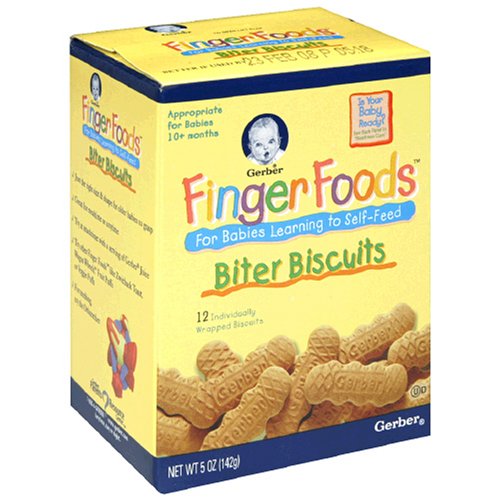
Be sure to label your containers with the contents of food and the date it was prepared. Most frozen foods will keep in the freezer for three to six months.
When ready, defrost and reheat your baby finger foods in small portions, depending on how much you expect your baby to eat. Always check that the food is not too hot before serving it to your baby. Uneaten portions of food should be discarded and never re-frozen and served.
Common defrosting and reheating methods include:
- Thawing food out in the fridge
- Microwaving
- Water bath (placing the food container in a warm water bath)
Keeping Your Baby Safe
One of the biggest fears parents have when it comes to introducing foods to their babies is choking. While both are scary, it’s important to understand the difference between gagging and choking so you’re fully prepared to respond. Additionally, there’s no evidence that baby-led weaning is riskier when it comes to choking versus traditional food introduction.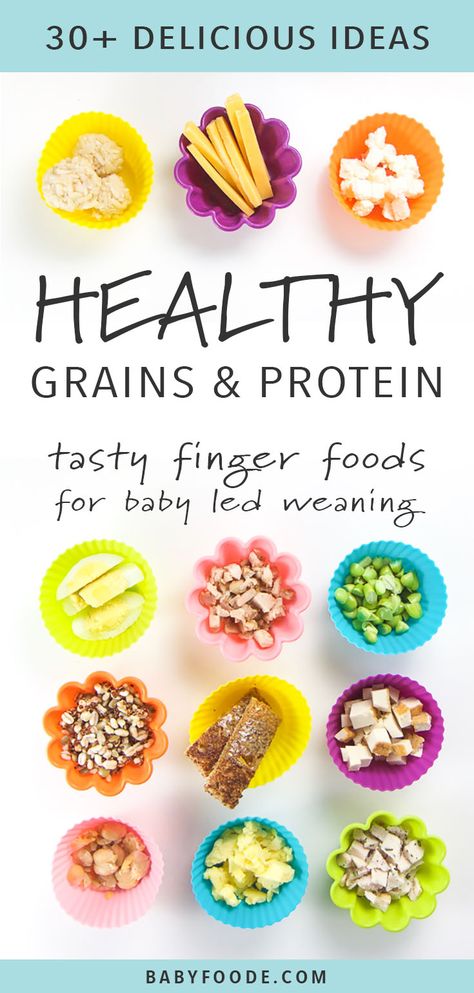
Gagging
The gag reflex is designed to protect your baby’s airway from food to prevent choking. When your child gags, it’s often the result of unchewed food going too far back in your child’s mouth.
Just like any other skill, feeding skills will take time. As your baby practices self-feeding, they will learn to chew more effectively and gagging should diminish with time.
The following are signs of gagging that while unpleasant, don’t necessarily require intervention:
- Coughing, sputtering, gurgling, and making gagging noises
- Skin may turn a darker shade
- Eyes may water
- Their tongue will thrust forward and they will spit up the food
- They may vomit the food
Choking
Choking occurs when a piece of food gets stuck into your baby’s throat which cuts off their air supply.
Signs of choking include:
- Baby is quiet or silent, unable to gasp or cry
- They will have trouble coughing or won’t cough at all
- They may have trouble breathing
- Skin may turn a bluish color
- May become unresponsive
The standard rescue procedure for choking is to begin abdominal thrusts, also known as the Heimlich maneuver.
Before introducing food to your baby, it’s important that you are trained in both abdominal thrusts and CPR to ensure your baby’s safety.
Additional tips on feeding your baby safely include:
- Avoid eating on the run by securing your child in a highchair or booster seat.
- Do not let siblings feed their baby brother or sister.
- Never leave your baby unsupervised with food.
- Avoid foods that present a choking risk.
Potential Choking Hazard
The following are foods that can pose a choking hazard for your child:
Fruits/Vegetables
- Cooked or raw whole corn kernels
- Uncut grape, cherry tomatoes, berries, cherries, or melon balls
- Pieces of hard fruit or vegetables like carrots, apples, or celery
- Whole pieces of canned fruit
- Uncooked dried vegetables or fruit, such as raisins or apricots
Proteins
- Whole or chopped nuts and seeds
- Chunks or spoonfuls of nut and seed butters, such as peanut butter or almond butter
- Tough or large chunks of meat
- Hot dogs, meat sticks, or sausages
- Shrimp
- Large chunks of cheese, especially string cheese and cheese cubes
- Bones in meat or fish
- Whole beans
Grain Products
- Cookies, brownies, granola bars
- Potato or corn chips, pretzels, popcorn, or similar snack foods
- Crackers or breads with seeds, nut pieces, or whole grain kernels
- Whole grain kernels of cooked barley, wheat, or other grains
- Plain wheat germ
Sweetened Foods
- Round or hard candy, jelly beans, caramels, gumdrops, or gummy candies
- Chewy fruit snacks
- Chewing gum
- Marshmallows
Your baby’s eating adventures will include many trials and tribulations, but also excitement and successes.
Whether you are following a traditional feeding approach, baby-led weaning, or a combination of the two, diving into the world of self-feeding has many benefits for your baby.
Self-feeding is an excellent way for your baby to develop hand-eye coordination, fine motor skills, and can foster a sense of independence paving the way for continued growth.
The content and advice provided in this article is for informational purposes only and is not a substitute for medical diagnosis, treatment, advice for specific medical conditions. Always consult a pediatrician to understand the individual needs of your child.
what products are possible, features of complementary foods
It is no secret that young and not very experienced mothers receive information on the nutrition of an infant, including recommendations on how to introduce the first complementary foods, mainly from two sources: grandmother's stories and from the Internet. Unfortunately, both of these respected sources of information may voluntarily or not voluntarily, but be very mistaken, since grandmothers grew up in a more prosperous time in terms of environmental conditions, and the Internet is littered with various articles that are rarely written by professionals, moreover, they rely either on explicit outdated guides on baby food, or frankly on unverified information. nine0003
nine0003
In this article, I will try to combine the latest scientific data and recommendations on how to introduce the first complementary foods with many years of observations from the experience of a practical pediatrician and an allergist-immunologist.
At what age is it time to introduce the first complementary foods
According to the recommendations of the Research Institute of Nutrition of the Russian Academy of Medical Sciences, the first complementary foods can be introduced from 4.5 - 5 months, regardless of the type of feeding. This is "average". In practice, the choice of when to start introducing complementary foods still depends on the individual characteristics of the child. For example, for a child with widespread atopic dermatitis (diathesis), we will not introduce complementary foods until at least acute skin symptoms, such as cracks, weeping or secondary eczema, have steadily disappeared. Increased dryness and flaking of the skin, of course, require constant application of moisturizers to the skin, but in no case are they a contraindication to the start of the introduction of the first complementary foods. nine0003
nine0003
Another important point when choosing the time to start introducing complementary foods is the dynamics of the child's weight gain. The more intensively the child gains in height and weight, the sooner he may need additional calories, since the energy value of breast milk or artificial formula alone will most likely not be enough for a child who grows faster than his peers by 4 - 5 months. We must not forget that natural products contain a fairly large range of minerals and vitamins, and a mother’s body, alas, cannot be an eternal and bottomless source of useful nutrients, somewhere something will gradually begin to be missed. nine0003
In addition, the nature of lactation in the mother has a great influence on the timing of the introduction of complementary foods. If a nursing mother begins to feel a lack of milk, I would prefer to first give her advice on stimulating lactation, and at the same time begin to introduce complementary foods. It will be better than introducing an artificial mixture. But I repeat that the earliest start date for the introduction of the first complementary foods is the age of 4 months, before the child's body is not yet ready, the risk of developing allergies is also high.
But I repeat that the earliest start date for the introduction of the first complementary foods is the age of 4 months, before the child's body is not yet ready, the risk of developing allergies is also high.
So, we agree with you that the first complementary foods can be introduced no earlier than 4 months of a child's life.
First complementary foods: Which foods to choose?
The first complementary foods, as a rule, should consist of vegetable or fruit purees, but in no case juices. Still, juices, even for children, are highly filtered, mainly contain a large amount of organic acids and “light” carbohydrates (that is, sugar, to make it clear to everyone). I will not waste time explaining why juices are harmful to an infant, but I will describe a clinical case from practice. nine0003
Parents with an 8-month-old girl came to the reception. Somewhere from 5 months she practically did not gain weight, although before that all indicators were normal. In the analyzes, apart from visible signs of iron deficiency, slightly reduced hemoglobin, no pathology was also detected. The main complaint: "does not eat anything." And when I began to find out what she still eats, it turned out that the child drinks half a liter of juice every day. But porridge or cottage cheese, or mashed potatoes cannot be forced together, they spit everything out. I don't like the taste. And so - for three months. The child, of course, became very nervous, yelling at night, demanding juice. nine0003
In the analyzes, apart from visible signs of iron deficiency, slightly reduced hemoglobin, no pathology was also detected. The main complaint: "does not eat anything." And when I began to find out what she still eats, it turned out that the child drinks half a liter of juice every day. But porridge or cottage cheese, or mashed potatoes cannot be forced together, they spit everything out. I don't like the taste. And so - for three months. The child, of course, became very nervous, yelling at night, demanding juice. nine0003
So draw your own conclusions and be careful.
For the first feeding, this is now recognized by everyone, the best dishes are vegetable purees from green varieties of vegetables: zucchini, cauliflower, broccoli. The first complementary foods are introduced, starting with half a teaspoon, in the morning for three days, then gradually increase the amount of the product to 40-50 grams per week. Supplemented with breast milk or formula.
For problems with stools, constipation, it’s good to start introducing prune puree, green apple, you can try pumpkin, even apricot puree, but in no case start with carrots. Beta-carotenoids, which are abundant in carrots, are generally poorly absorbed and can cause allergies in a child. nine0003
Beta-carotenoids, which are abundant in carrots, are generally poorly absorbed and can cause allergies in a child. nine0003
Second food. Porridge or meat?
Even 5 - 6 years ago, we taught students at the medical institute that from 5 - 5.5 months old, an infant should begin to give cereal porridge for complementary foods. This is rice, buckwheat, corn. The first week you can cook 5% porridge: 5 grams of ground cereal per 100 ml of water. Then the porridges are cooked already denser: 10 grams of cereal per 100 ml of water. But now, basically everyone uses instant (soluble) cereals, which are diluted with water according to the instructions on the package. In addition, ready-to-eat liquid cereals are on sale: for example, Bellakt, Frutonyanya, etc. nine0003
Why meat? You ask. According to modern recommendations (they really began to change quite often), but in this case I support: if a child has a pronounced decrease in hemoglobin in the blood below 100 g / l by the age of 5 months, it makes sense to start introducing fruit or vegetable purees as a second types of complementary foods - meat purees as a source of the most well-absorbed heme iron. You need to choose from varieties such as turkey, rabbit, lamb. Beef and veal can only be offered to children who did not have red cheeks and diathesis. nine0003
In the absence of problems with low hemoglobin, feel free to introduce porridge as the second meal of complementary foods, especially if the child is small and does not gain weight very well. In this case, we can recommend breeding cereals with the addition of breast milk or a mixture (Nan, Nutrilon, Celia, Nanny). With mixtures based on goat's milk, parents of children with a predisposition to allergies should be very careful. Goat milk formulas are not the best choice for babies who are allergic or intolerant to cow's milk protein, whatever the internet says. Believe me, there are serious scientific articles by foreign authors, which provided data on a very high frequency of cross-allergy between cow and goat milk proteins in children who were transferred to goat milk mixtures. And I saw it myself in my practice, when a child with dermatitis was transferred to a mixture of goat's milk, there was a clear improvement for a month or two, and then all over again and with a doubled degree of allergic skin damage. nine0003
nine0003
Introduction to fermented milk products
This is the most difficult question. I am sure that most of our grandparents demand that their stupid parents start drinking milk and kefir as soon as possible. In a number of cases, children really start to absorb sour-milk products quite well after 6 months, but before this age I am very careful even with sour-milk Agusha, and even introducing milk or kefir before 6 months is a bad form, believe me, and can lead to very bad consequences for the child. I understand the Western European medical community, which has recently banned its pediatricians from recommending fermented milk products for complementary foods for children under 3 years of age, just imagine! nine0003
They (the Europeans) need to do something with their artificial milk mixtures. Even 20 years ago, we did not know other mixtures after the "two", that is, the second formula for children from 6 to 12 months. Then there were formulas for children from 1 to 2 years old, then from 2 to 3 years old, and now there are already mixtures for children up to 4 years old, and I think if this goes on, then until the age of sixteen there will be their own milk substitutes. Dismiss me, I don't think this approach is correct. But the fact is that our grandparents had much better genetics than the generation of our children, alas. In the context of the growth of medical capabilities, genetically determined diseases are also growing, and in this case, intolerance to cow's milk protein, and with every 10 years there are more and more such people among us. But if a child really suffers from an allergy to cow's milk protein or is severely deficient in enzymes, then he will carry this peculiarity through his whole life, and most likely he will not drink milk or kefir himself, and there is no need to force him if he himself won't want to! nine0003
Dismiss me, I don't think this approach is correct. But the fact is that our grandparents had much better genetics than the generation of our children, alas. In the context of the growth of medical capabilities, genetically determined diseases are also growing, and in this case, intolerance to cow's milk protein, and with every 10 years there are more and more such people among us. But if a child really suffers from an allergy to cow's milk protein or is severely deficient in enzymes, then he will carry this peculiarity through his whole life, and most likely he will not drink milk or kefir himself, and there is no need to force him if he himself won't want to! nine0003
But you are lucky with genetics, and no one in the family has ever had an allergy (which is hard to imagine nowadays), and most importantly, if your child has always had perfectly clean skin, then the first of the dairy products - cottage cheese, you will begin to offer your child with 7 months, kefir - from 10 months. Milk - after a year. It will be better this way.
Milk - after a year. It will be better this way.
But if your family does not have a very close and joyful relationship with milk, then it is better to postpone even the introduction of kefir and yogurt into complementary foods for a child until the age of 18 months. nine0003
Fish day and first meal
Fish is a very healthy product, rich in vitamins and antioxidants, but it must also be introduced carefully. I advise you to start introducing the first fish food at about 7-8 months. It is better to start with species such as cod, hake, haddock. The rules are the same: the first three days on the "gram," then slowly add. If there are no problems in a week or two, you can try such delicacies as tuna or salmon, of course, canned children, if you can find it. It is better not to mess with trout and salmon in the first year of life, this fish is all stuffed with dyes and antibiotics. nine0003
No matter how hard I tried, the article about the first complementary foods turned out to be long.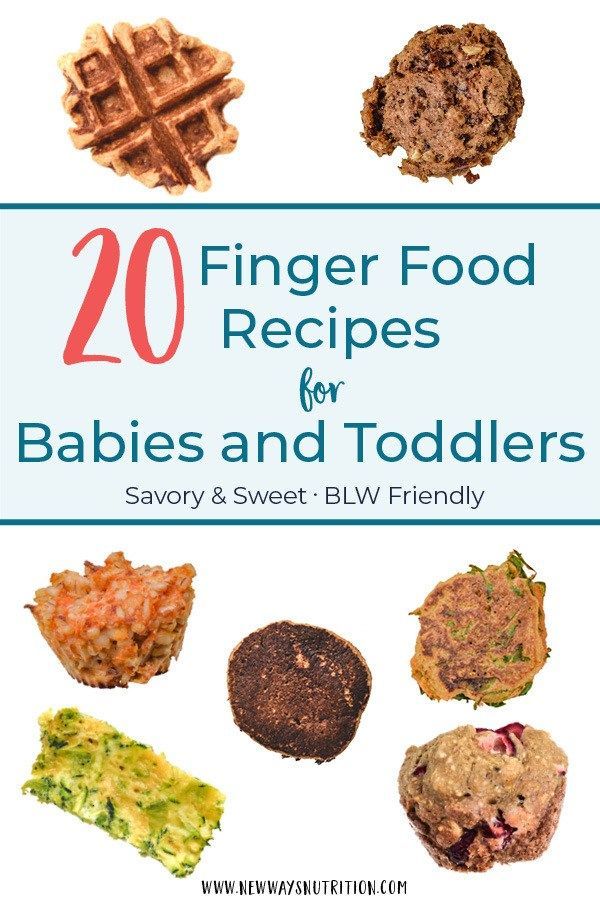 Thank you for reading to the end, I hope it will be useful. If you have questions about the introduction of complementary foods, you can write your appeals on our website in the question to a specialist section. A short answer can be obtained on the Internet, but in order to make a diagnosis and give a detailed consultation, of course, you need to come to a face-to-face appointment with a pediatrician and a pediatric allergist.
Thank you for reading to the end, I hope it will be useful. If you have questions about the introduction of complementary foods, you can write your appeals on our website in the question to a specialist section. A short answer can be obtained on the Internet, but in order to make a diagnosis and give a detailed consultation, of course, you need to come to a face-to-face appointment with a pediatrician and a pediatric allergist.
Diet for a child aged 4-6 months
Your baby is already 4 months old. He has noticeably grown up, become more active, is interested in objects that fall into his field of vision, carefully examines and reaches for them. The emotional reactions of the child have become much richer: he joyfully smiles at all the people whom he often sees more and more often, makes various sounds.
You are still breastfeeding your baby or have had to switch to mixed or formula feeding. The child is actively growing, and only with breast milk or infant formula, he can no longer always get all the necessary nutrients. And that means it's time to think about complementary foods. nine0003
And that means it's time to think about complementary foods. nine0003
The optimal time to start its introduction is between 4 and 6 months, regardless of whether the baby is receiving breast milk or formula. This is the time when children respond best to new foods. Up to 4 months, the child is not yet ready to perceive and digest any other food. And with the late introduction of complementary foods - after 6 months, children already have significant deficiencies of individual nutrients and, first of all, micronutrients (minerals, vitamins, long-chain polyunsaturated fatty acids, etc.). In addition, toddlers at this age often refuse new foods, they have delayed development of chewing skills for thick foods, and inadequate eating habits are formed. It is important to know that, no matter how strange it may seem at first glance, with a delayed appointment of complementary foods, allergic reactions more often occur on them. nine0003
When is it advisable to introduce complementary foods as early as 4 months, and when can you wait until 5. 5 or even 6 months? To resolve this issue, be sure to consult a pediatrician.
5 or even 6 months? To resolve this issue, be sure to consult a pediatrician.
As a rule, at an earlier age (4 - 4.5 months), complementary foods are introduced to children at risk of developing iron deficiency anemia, as well as children with insufficient weight gain and with functional digestive disorders.
The optimal time to start complementary foods for a healthy baby is between 5 and 5.5 months of age. nine0003
The World Health Organization recommends that breastfed babies should be introduced to complementary foods from 6 months of age. From the point of view of domestic pediatricians, which is based on extensive practical experience and scientific research, this is possible only in cases where the child was born on time, without malnutrition (since in these cases the mineral reserves are very small), he is healthy, grows well and develops. In addition, the mother should also be healthy, eat well and use either specialized enriched foods for pregnant and lactating women, or vitamin and mineral complexes in courses. Such restrictions are associated with the depletion of iron stores even in a completely healthy child by 5-5.5 months of age and a significant increase in the risk of anemia in the absence of complementary foods rich or fortified with iron. There are other deficits as well. nine0003
Such restrictions are associated with the depletion of iron stores even in a completely healthy child by 5-5.5 months of age and a significant increase in the risk of anemia in the absence of complementary foods rich or fortified with iron. There are other deficits as well. nine0003
The first complementary food can be vegetable puree or porridge, fruit puree is better to give the baby later - after tasty sweet fruits, children usually eat vegetable puree and cereals worse, often refuse them altogether.
Where is the best place to start? In cases where the child has a tendency to constipation or he puts on weight too quickly, preference should be given to vegetables. With a high probability of developing anemia, unstable stools and small weight gains - from baby cereals enriched with micronutrients. And if you started introducing complementary foods with cereals, then the second product will be vegetables and vice versa. nine0003
If the first complementary food is introduced at 6 months, it must be baby porridge enriched with iron and other minerals and vitamins, the intake of which with breast milk is no longer enough.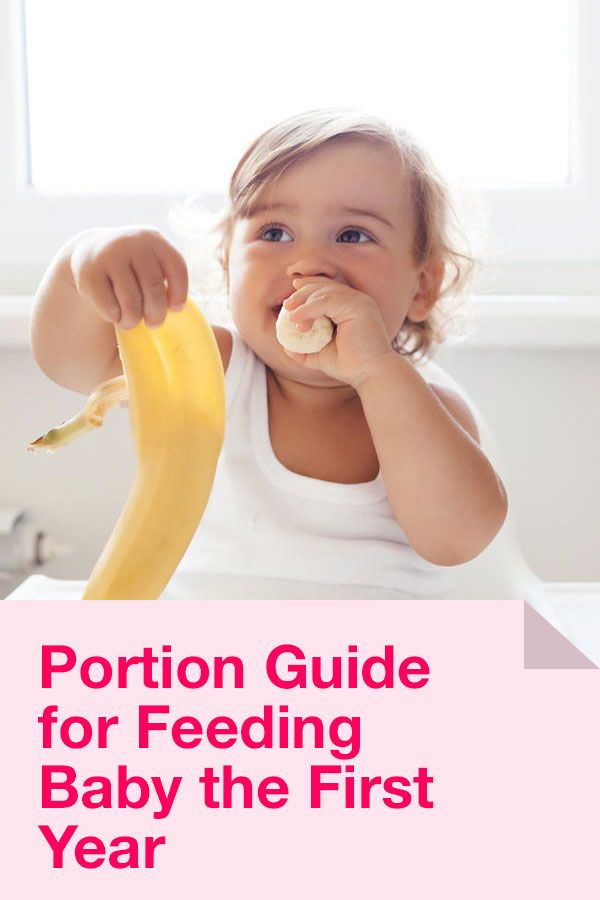
Another important complementary food product is mashed meat. It contains iron, which is easily absorbed. And adding meat to vegetables improves the absorption of iron from them. It is advisable to introduce meat puree to a child at the age of 6 months. Only the daily use of children's enriched porridge and meat puree can satisfy the needs of babies in iron, zinc and other micronutrients. nine0003
But it is better to introduce juices later, when the child already receives the main complementary foods - vegetables, cereals, meat and fruits. After all, complementary foods are needed so that the baby receives all the substances necessary for growth and development, and there are very few in their juices, including vitamins and minerals.
Juices should not be given between feedings, but after the child has eaten porridge or vegetables with meat puree, as well as for an afternoon snack. The habit of drinking juice between meals leads to frequent snacking in the future, a love of sweets is instilled, children have more tooth decay and an increased risk of obesity. nine0003
nine0003
With the start of the introduction of complementary foods, the child is gradually transferred to a 5-time feeding regimen.
Rules for the introduction of complementary foods:
- preference should be given to baby products of industrial production, they are made from environmentally friendly raw materials, have a guaranteed composition and degree of grinding
- Complementary foods should be offered to the baby by spoon at the start of feeding, before breastfeeding (formula feeding)
- the volume of the product increases gradually, starting with ½ - 1 spoon, and in 7 - 10 days we bring it to the age norm, subsequent products within the same group (cereals from other cereals or new vegetables)
- can be entered faster, in 5 - 7 days
- start introduction with monocomponent products
- it is undesirable to give a new product in the afternoon, it is important to follow how the child reacts to it
- do not introduce new products in the event of acute illnesses, and before and immediately after prophylactic vaccination (should be abstained for several days)
When introducing a new type of complementary food, first try one product, gradually increasing its amount, and then gradually "dilute" this product with a new one. For example, vegetable complementary foods can be started with a teaspoon of zucchini puree. During the week, give the baby only this product, gradually increasing its volume. After a week, add a teaspoon of mashed broccoli or cauliflower to the zucchini puree and continue to increase the total volume every day. Vegetable puree from three types of vegetables will be optimal. The portion should correspond to the age norm. Over time, you can replace the introduced vegetables with others faster. nine0003
For example, vegetable complementary foods can be started with a teaspoon of zucchini puree. During the week, give the baby only this product, gradually increasing its volume. After a week, add a teaspoon of mashed broccoli or cauliflower to the zucchini puree and continue to increase the total volume every day. Vegetable puree from three types of vegetables will be optimal. The portion should correspond to the age norm. Over time, you can replace the introduced vegetables with others faster. nine0003
After the introduction of one vegetable (bringing its volume to the required amount), you can proceed to the intake of porridge, and diversify the vegetable diet later.
If the child did not like the dish, for example, broccoli, do not give up and continue to offer this vegetable in a small amount - 1-2 spoons daily, you can not even once, but 2-3 times before meals, and after 7 - 10, and sometimes 15 days, the baby will get used to the new taste. This diversifies the diet, will help to form the right taste habits in the baby. nine0003
Spoon-feeding should be done with patience and care. Forced feeding is unacceptable!
In the diet of healthy children, porridge is usually introduced after vegetables (with the exception of healthy breastfed children, when complementary foods are introduced from 6 months). It is better to start with dairy-free gluten-free cereals - buckwheat, corn, rice. At the same time, it is important to use porridge for baby food of industrial production, which contains a complex of vitamins and minerals. In addition, it is already ready for use, you just need to dilute it with breast milk or the mixture that the baby receives. nine0003
Children suffering from food allergies are introduced complementary foods at 5-5.5 months. The rules for the introduction of products are the same as for healthy children, in all cases it is introduced slowly and begins with hypoallergenic products. Be sure to take into account individual tolerance. The difference is only in the correction of the diet, taking into account the identified allergens.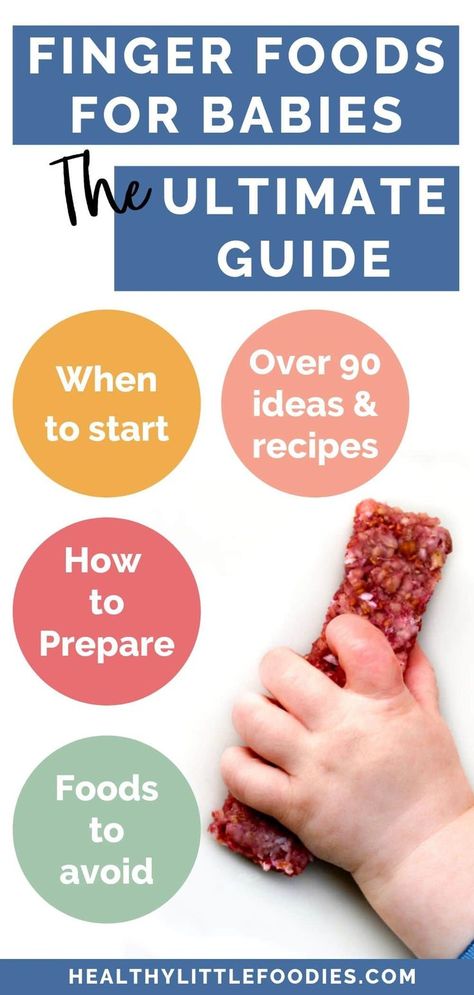 From meat products, preference should first be given to mashed turkey and rabbit.
From meat products, preference should first be given to mashed turkey and rabbit.
Diets for different age periods
Explain how you can make a diet, it is better to use a few examples that will help you navigate in compiling a menu specifically for your child.
From 5 months, the volume of one feeding is on average 200 ml.
Option 1.
If your baby started receiving complementary foods from 4-5 months, then at 6 months his diet should look like this:
| Breast milk or VHI* | 200 ml | |
| II feeding 10 hours | Dairy-free porridge** Supplementation with breast milk or VHI* | 150 g 50 ml |
| III feeding 14 hours | Vegetable puree Meat puree Vegetable oil Supplemental breast milk or VHI* | 150 g 5 - 30 g 1 tsp 30 ml |
| IV feeding 18 hours | Fruit puree Breast milk or VHI* | 60 g 140 ml |
| V feeding 22 hours | Breast milk or VHI* | 200 ml |
* - infant formula
** - diluted with breast milk or VHI
Option 2.
* - infant formula Option 3. : ** - diluted with breast milk Up to 7 months, increase the volume of porridge and vegetable puree to 150 g and introduce fruit puree. I feeding
6 hours Breast milk or VHI* 200 ml II feeding
10 hours Dairy-free porridge**
Fruit puree 150 g
20 g III feeding
14 hours Vegetable puree
Meat puree Vegetable oil
Fruit juice 150 g
5 - 30 g
1 tsp
60 ml IV feeding
18 hours Fruit puree
Breast milk or VHI* 40 g
140 ml V feeding
22 hours Breast milk or VHI* 200 ml
** - diluted with breast milk or VHI 
I feeding
6 hours Breast milk II feeding
10 hours Dairy-free porridge**
Breast milk supplement 100 g III feeding
14 hours Vegetable puree
Meat puree Vegetable oil
Breast milk supplement 100 g
5 - 30 g
1 tsp IV feeding
18 hours Breast milk V feeding
22 hours Breast milk 




